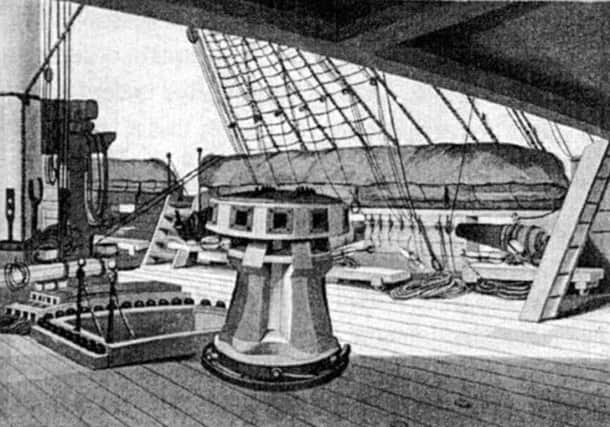Life aboard a sailing ship of old


She starts by detailing what life was like aboard the wooden vessel.
“Smoking was prohibited everywhere on board ship apart from the forecastle, as was the use of candles in bed, which would have been a hazardous occupation in a wooden sailing ship in the middle of the Indian Ocean while being hurled about in a hammock!”
Advertisement
Hide AdAdvertisement
Hide AdDuring their journey to England, The Hindostan made good progress, with the fleet never far away.
“The crew were well occupied on the masts and rigging and hauling cables.
“A great deal of time was spent painting the ship and boats on deck.”
The ship’s log records that by March 21, the two ships were part of a fleet of 14 merchantmen and two frigates.
Advertisement
Hide AdAdvertisement
Hide Ad“It states that on leaving Ceylon, the crew are employed in stowing the anchor and unbending the cables and topsails. There are spars that need to be stowed away too.
“A few days later the weather deteriorates and becomes squally with rain. Lightning is recorded. Undeterred, the crew are tasked with removing bags of rice from the aft hold into the main hatchway.”
Each Sunday, the ship’s company is mustered while water expenditure is carefully noted each day.
The blue lamp was lit at times of poor visibility and poor conditions to prevent collisions when sailing in close order.
Advertisement
Hide AdAdvertisement
Hide AdDorothy explains that heavy seas would have washed perilously over the deck, seeping into the ship, and the bilge pumps would have been worked continuously by the crew.
“Winds and pounding waves kept the Cape of Good Hope waters in constant turmoil. It would have been a very frightening experience for all the children and adult passengers on board.”
In 1839, Leon Ducharme, a Canadian prisoner on board the Hindostan wrote of a storm he experienced: “ The sea was so disturbed and the ship so tossed about, that it was impossible for us to keep our feet or to remain seated without clinging desperately to some object.
“You would have sworn that every minute the ship would have gone to the bottom; the waves pounded her so fiercely that she seemed to be hurling herself against a rock. The sea was quite white, and made a terrifying moan; the waves rose to a fearful height.”
Advertisement
Hide AdAdvertisement
Hide AdYet despite such adversity, finally, on Sunday, August 8, at 2pm, the coast of England was sighted and a signal was sent out for ships to bring to.
“At 3pm the order for the mizen to be shortened was given and the Jolly Boat lowered down.
“The ship’s company busied themselves bending cables and preparing the ship for harbour.
“On Monday, August 9, the captain recorded that the ship was five leagues from the shore.
Advertisement
Hide AdAdvertisement
Hide Ad“It was at this point when the Niemen frigate, when the convoy was passing up the Channel, that a signal was made from the Selsea Signal House alerting them to the presence of a French Privateer.
“The Niemen along with the Astrea and Tyneside-built Bucephalus immediately gave chase with success.
“At 6am most of the passengers left the ship and the Downs Pilot took charge.
“At 8am, Dungeness and Culver Cliffs came into view.
“The next day, on the 10th, the Hindostan makes its way slowly into the Downs, off the East coast of Kent.
Advertisement
Hide AdAdvertisement
Hide Ad“On Thursday, August 12, they unfortunately grounded the lower part of the ship, but the following day they managed to get afloat again.
“At 3pm the ship came abreast of Woolwich and they ran the kedger (small anchor) in, to steady her in deep waters.
“A little before low water she took the ground. At 11pm they once more made sail and dropped anchor at Blackwall.”
Dorothy says that the log of the Hindostan’s six-month maiden voyage ends in Blackwall where there would have been much activity around the ship, as Thames Longshoremen unloaded her cargo which would have been stored in one of the many warehouses on the river.
Advertisement
Hide AdAdvertisement
Hide Ad“My ancestor, James Bonner and his children, at long last on firm land, made their way to rented accommodation at Gloucester Place, Kentish Town.
“On October 7, 1813, the Admiralty decided, following negotiations with David Webster, on behalf of the builders Bonner & Horsburgh, that the Hindostan and Severn be purchased by the Royal Navy.
“Included in the price was the rigging, the furniture and guns and ammunition.
“The Hindostan was sold for £18,000 (and became HMS Buffalo) and the Severn for £17,000 (becoming HMS Camel).
“Both were commissioned into the Navy in November 1813.
Advertisement
Hide AdAdvertisement
Hide Ad“Twenty three years later, and HMS Buffalo made her name in Australian history by bringing Hindmarsh, the first Governor of South Australia, to take up his office, along with immigrants, to start the new colony.
“James Bonner died in 1824, aged 53, in his house on Marygate, near the Scotch Gate, in Berwick-upon-Tweed and was described as a landed gentleman.
“His will leaves almost all of his estate in equal shares to his 10 children, six of whom were born in India.”